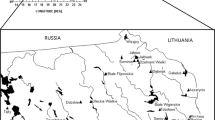Abstract
The 238,239+240Pu activity concentrations in sediments and in water in the Crimean salt lakes were studied. Activity ratio of 238Pu/239+240Pu in depth profiles of sediments was used to estimate the contribution of two main sources of man-made plutonium to the Pu sediment inventory. The most part of the plutonium was of global origin. Concentration factor of the plutonium isotopes in sediments, radiocapacity factor of the lake, the type of biogeochemical behavior of plutonium in these reservoirs and the sediment inventory of 238,239+240Pu in the lakes were evaluated.




Similar content being viewed by others
References
Warner F, Harrison RM (eds) (1993) Radioecology after Chernobyl: biogeochemical pathways of artificial radionuclides. Wiley, Chichester
Worldwide marine radioactivity studies (2005) Radionuclide levels in oceans and seas. IAEA, Vienna. IAEA-TECDOC-1429
Polikarpov G, Egorov V, Gulin S, Stokozov N, Lazorenko G, Mirzoeva N, Tereshchenko N, Tsytsugina V, Kulebakina L, Popovichev V, Korotkov A, Evtushenko D, Zherko N, Malakhova L (2008) Radioecological response of the Black Sea to the Chernobyl accident. EKOSI-Gidrophisica, Sevastopol (in Russian)
Remeikis V, Gvozdaite R, Druteikiene R, Plukis A, Tarasiuk N, Špirkauskaite N (2005) Plutonium and americium in sediments of Lithuanian lakes. Nukleonika 50:61–66
Gudkov D, Kireev S, Nazarov A, Klenus V, Kaglyan A (2010) Radionuclides in ecosystems of ponds in the Chernobyl NPP exclusion zone. In: Romanenko VD (ed) Tecnogenic radionuclides in freshwater ecosystems. Naukova Dumka, Kiev (in Ukrainian)
Trapeznikov A, Molchanova I, Karavaeva E, Trapeznikova V (2007) Migration of radionuclides in freshwater and terrestrial ecosystems, vol I. Ural Univ. Publ, Hous, Ekaterinburg (in Russian)
Zheng J, Liao H, Wu F, Yamada M, Fu P, Liu C, Wan G (2008) Vertical distributions of 239+240Pu activity and 240Pu/239Pu atom ratio in sediment core of Lake Chenghai, SW China. J Radioanal Nucl Chem 275:37–42
Oliferov A, Timchenko Z (2005) Rivers and Lakes of Crimea. Dolya, Simferopol (in Russian)
Pasynkov A, Sotskova L, Chaban V (2014) Ecological problems of conservation and use of balneological resources of salt lakes in the Crimea. Sci Notes Ttaurian Natl Univ Geogr 27:96–116 (in Russian)
Shadrin N (2008) The Crimean hypersaline lakes: general peculiarities. In: Tokarev Y, Finenko Z, Shadrin N (eds) The Black Sea microalgae: problems of biodiversity preservation and biotechnological usage. EKOSI-Gidrophisica, Sevastopol (in Russian)
Anufriieva E (2018) How can saline and hypersaline lakes contribute to aquaculture development? A review. J Oceanol Limnol 36:2002–2009. https://doi.org/10.1007/s00343-018-7306-3
Tereshchenko N, Gulin S, Proskurnin V (2018) Distribution and migration of 239,240Pu in abiotic components of the Black Sea ecosystems during the post-Chernobyl period. J Environ Radioact. https://doi.org/10.1016/j.jenvrad.2017.10.002
Barjakhtar V (ed) (1995) Chernobyl accident. Naukova dumka, Kiev (in Russian)
Tereshchenko N, Proskurnin V, Paraskiv A, Chuzhikova-Proskurnina O (2018) Man-made plutonium radioisotopes in the salt lakes of the Crimean peninsula. Chin J Oceanol Limnol. https://doi.org/10.1007/s00343-018-7312-5
La Rosa J, Gastaud J, Lagan L, Lee S-H, Levy-Palomo I, Povinec P, Wyse E (2005) Recent developments in the analysis of transuranics (Np, Pu, Am) in seawater. J Radioanal Nucl Chem. https://doi.org/10.1007/s10967-005-0604-1
Tereshchenko N (2008) Method of determination of transuranium elements (plutonium and americium) in the environment. Radioecological response of the Black Sea to the Chernobyl accident. In: Polikarpov GG, Egorov VN (eds) Radioecological response of the Black Sea to the Chernobyl accident. EKOSI-Gidrophisica, Sevastopol (in Russian)
Buesseler K, Livingston H (1996) In: Guẻguẻniat P, Germain P, Mẻtivier H (eds) Radionuclides in the ocean: inputs and inventories. IPSN, Cherbourg
Tereshchenko N, Proskurnin V, Gulin S, Paraskiv A (2018) Geochronological reconstruction of sedimentation flows of technogenic plutonium based on the radioisotope determination of the sedimentation rate of suspended matter in sediments on a half-century scale. In: Lisitsin AP (ed) The Black Sea System. Scientific World, Moscow. https://doi.org/10.29006/978-5-91522-473-4.2018.641(in Russian)
Polikarpov G, Lazorenko G (1992) Role of bottom sediments of the Black Sea reduction and oxidation zones in the extraction of radionuclides from the water environment. In: Polikarpov GG (ed) Molismology of the Black Sea. Naukova Dumka, Kiev (in Russian)
Gulin S, Mirzoyeva N, Egorov V, Polikarpov G, Sidorov I, Proskurnin V (2013) Secondary radioactive contamination of the Black Sea after Chernobyl accident: recent levels, pathways and trends. J Environ Radioact 124:50–56
Polikarpov G (ed) (1984) Marine radiochemoecology and problem of pollution. Naukova dumka, Berlin (in Russian)
Hardy E, Krey P, Nolchor H (1973) Global inventory and distribution of fallout plutonium. Nature 241:444–445
Aarkrog A (1988) The radiological impact of the Chernobyl debris compared with that from nuclear weapons fallout. J Environ Radioact 6:151–162
Acknowledgements
The study of the Crimean salt lakes was supported by the Russian Scientific Foundation, Grant No. 18-16-00001 and the marine investigation was fulfilled within the framework of the state assignment of the IBSS of RAS No. AAAA-A18-118020890090-2.
Author information
Authors and Affiliations
Corresponding author
Additional information
Publisher's Note
Springer Nature remains neutral with regard to jurisdictional claims in published maps and institutional affiliations.
Rights and permissions
About this article
Cite this article
Tereshchenko, N.N., Trapeznikov, A.V., Paraskiv, A.A. et al. Activity concentration of plutonium isotopes in bottom sediments and water in Crimean salt lakes. J Radioanal Nucl Chem 326, 1019–1025 (2020). https://doi.org/10.1007/s10967-020-07388-y
Received:
Accepted:
Published:
Issue Date:
DOI: https://doi.org/10.1007/s10967-020-07388-y



